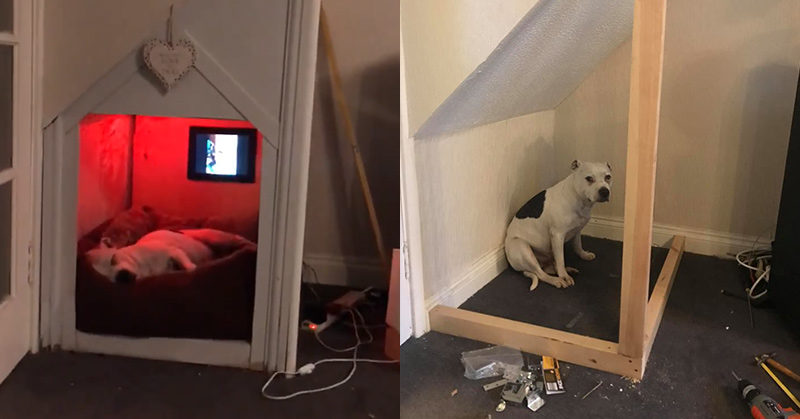Adopting a dog can be a wonderfully rewarding experience. Not only do you get to have the dog you’ve always wanted, but you have the opportunity to help an animal in need, and provide a loving home for a dog who has potentially been mistreated.
Adopted dogs can, however, sometimes pose challenges that other dogs do not. If the dog comes from an abusive situation, it may struggle with fear, anxiety, or aggression, and it may take a long time before your new dog is able to fully trust you.
Sean Farrell experienced this problem with his adopted dog, Buster, so he came up with a creative solution: he built a tiny house for his rescue dog, so that Buster could get some alone time.
Read: Top vets urge dog lovers to stop buying pugs and bulldogs
A Tiny Home for a Rescue Dog
Buster is a Staffordshire Bull Terrier who was rescued from an abusive home. Sean Ferrell heard about Buster’s situation and agreed to take him in just for the time-being until a permanent home was found for him [1].
Not surprisingly, Ferrell became attached to Buster and ended up adopting him instead. Despite being in a loving home, Buster was still struggling with the lingering emotional effects of his past. For this reason, Buster would go for walks with Ferrell, eat with him, and did not mind when guests came over, but Ferrell noticed that throughout the day he would always look for a quiet part of the house to be alone and rest.
Ferrell has been very patient with Buster and has helped him overcome some of his trauma, but also respects his dog’s need for space. To facilitate this, he built a tiny house in the living room for his rescue dog to go when he needed to be alone.
With just a few two by fours and some plywood, Ferrell managed to put together a small house for Buster, complete with a window with a view into the rest of the living room. It also includes a small fan and a comfortable bed on which Buster can sleep.
Ferrell’s efforts have done wonders to help Buster, and today he is a therapy dog who goes into homes as well as a brain injury clinic nearby to comfort people who have social struggles, autism, and anxiety [1].
Read: Retired Nurse Creates a Hospice for Dying Dogs
Thinking of Adopting a Dog?
In general, getting a dog is a big commitment. Adopting a dog, however, can require even more work and patience.
About 3.2 million people adopt a rescue pet every year, and for the most part, these animals are well-adjusted and happy. There are many reasons why a dog could end up in a shelter beyond coming from an abusive home, and so there is a misconception that all adopted dogs will have behavioral problems as a result of their traumatic pasts [2].
It is important to understand, however, that in some cases the shelter workers will not know exactly what kind of conditions some of their animals have come from, and how that might have affected them. When you adopt a dog, you should be ready to work with that animal according to his or her emotional needs.
It is also likely that your new dog will be scared at first. He has probably just been through an exhausting ordeal, and shelters are often not calm, quiet places. You will have to exercise patience with your new pup as he adjusts to his new surroundings, and as he learns to rust you as his owner.
If you have children, experts warn that you should never leave them alone with a rescue dog. This is because your dog could have unpredictable behaviour as a result of past trauma, even if she passed a temperament test. Until she is comfortable in her new home, it is best to be cautious.
You may also want to pet-proof your home. This means clearing away any items like small toys that could be swallowed, loose wires, medicines, cleaning solutions, and house plants that could be poisonous to animals [2].
Give Your Dog Time
The most important thing to remember when adopting a dog is to be patient with them. If they are coming from an abusive situation, all they know is that they are no longer in that place. They don’t understand, however, that you aren’t going to do the same thing, so it may take them a long time to warm up to you.
Give your new dog a chance to adjust to their new surroundings, provide them with as much love and care as you can, and eventually they will come to learn that your home is a safe place for them [2].
Keep Reading: Man Made His Wife Choose Between Her Rescue Dogs And Him – She Picked The Dogs

